
GUEST POST from Jesse Nieminen
I recently read a couple of excellent articles by Nick Skillicorn, and Prof. Rita McGrath where both discuss the challenges and intricacies involved in structuring and governing innovation within a large organization.
This is a classic topic that every corporate innovator has without a doubt come across, and it’s also one where “the right approach” is often quite elusive.
Inspired by those articles, we’ll present the most common archetypes and then dig a little deeper on the topic and share our thoughts and experiences to help you figure out how innovation should be structured within your organization.
Why organizing innovation is challenging
Before we dive into the different models for governing and organizing innovation, it’s important to understand why this is such a challenging topic to begin with.
That’s of course quite a lengthy and nuanced topic, but in short, there is no such thing as a perfect organizational structure or governance model. The bottom line is that a large organization is simply such a complex entity that structuring everything perfectly so that there aren’t any kind of bottlenecks, misaligned incentives, or any duplication of work just isn’t very realistic. If you’ve ever worked in large organization, you’ve certainly come across some of these challenges.
Now, most of these challenges are likely to be worse with innovation than with “business as usual” as, by definition, innovation means introducing changes. And most organizations simply aren’t designed for constant change.
What’s more, businesses are naturally very different from one another. A structure that works for a single product software company probably isn’t ideal for a CPG manufacturer or a house of brands because not only are their industries different, so are the innovations they are going after. So, what works well for some organization probably won’t be ideal for you.
This means that benchmarking and then applying “best practices” likely won’t work too well. Unfortunately, there just isn’t a single correct way to organize innovation.
Exploring the organizational archetypes for innovation
Having said that, there are a handful of common approaches, which we like to call archetypes, that most organizations use as the foundation for their efforts to organize and govern innovation.
Both McGrath and Skillicorn have done an excellent job in presenting many of these approaches, so a lot of credit for the following descriptions goes to them and I’d warmly recommend you read their takes too. Regardless, we’ve summarized their main points and combined them with our own experiences to create the following archetypes.
We’ll next explain each of these briefly, along with a quick summary of the key strengths and weaknesses for each.
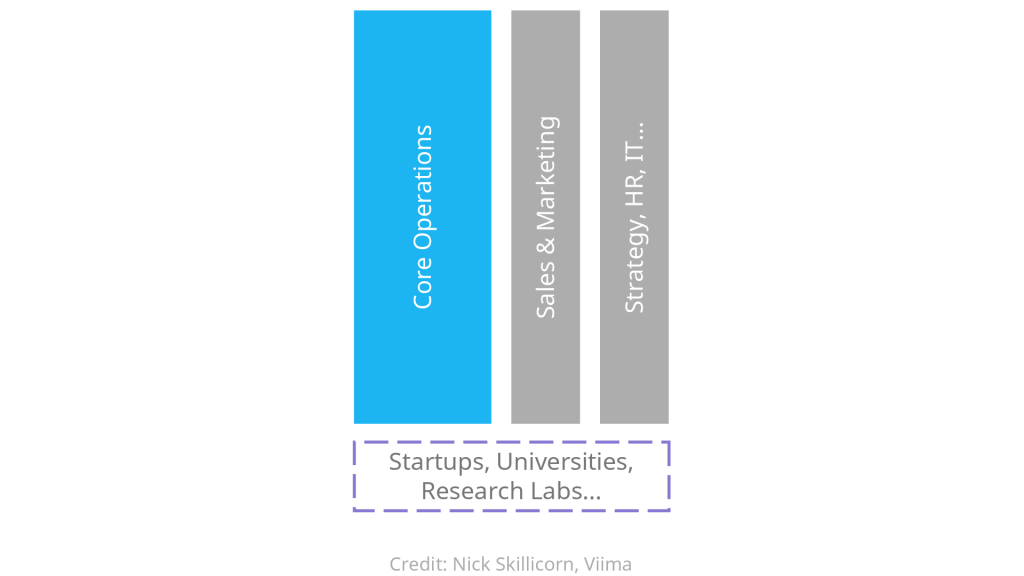
No in-house innovation
The first and simplest way to organize innovation is to not do it, or to completely outsource it. Perhaps the most common method here is to simply keep tabs on promising startups and then acquire them, or to have tight collaboration with universities and other research institutions.
While this obviously keeps things simple organization-wise and minimizes fixed costs, it also means that you no longer have control over your own destiny, and are instead reliant on third parties, which puts you in a very vulnerable position long term. Furthermore, in the last decade, we’ve seen a huge inflow of capital to fund startups, which means that valuations for promising startups have skyrocketed and acquiring them on the cheap is simply no longer a very feasible strategy.
Suffice to say, if you want to build an organization that thrives in the long run, I wouldn’t recommend this approach.
Pros
- Low fixed costs
- Structurally simple
Cons
- Lack of strategic control and ability to build the future of the organization
- Lack of differentiation
- Reliance on third parties for both execution and especially exploration
- Acquisition of promising innovations has become expensive
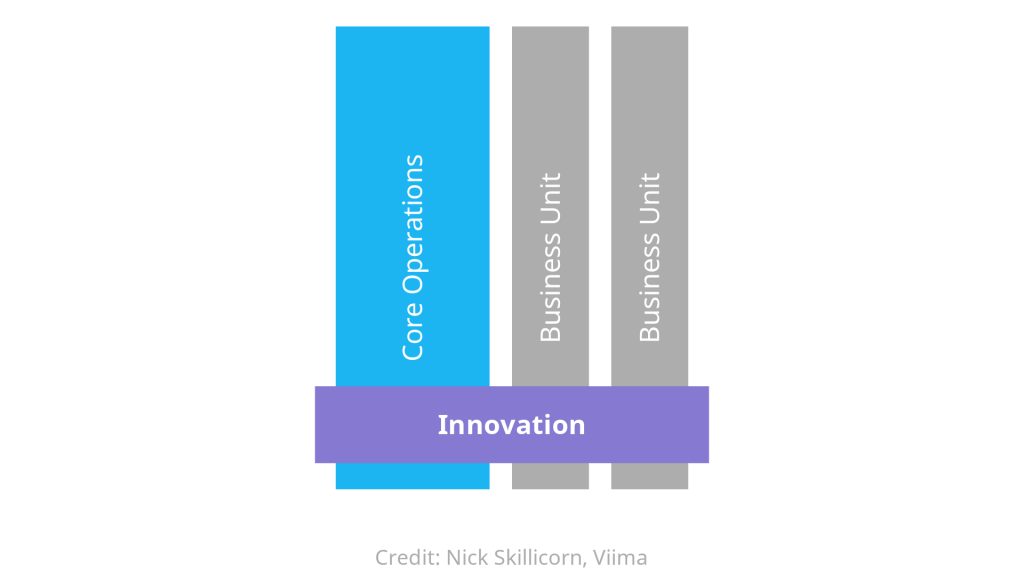
Centralized
Perhaps the most common way large organizations set up innovation is by creating a centralized department that serves the innovation needs of the entire organization including each business unit and support functions, such as IT or HR. This can be a subdivision within R&D, but these days it’s typically a separate cross-departmental unit serving the innovation needs of business units.
Either way, such a unit is quick and easy to set up, and the approach has some other obvious advantages too, such as innovation expertise being built and managed centrally, which speeds up learning, as well as management and reporting being easy to organize.
It’s these advantages that make centralization the obvious choice for many who are just starting out with innovation. This is also an especially common approach for large industrial companies that typically have a strong R&D tradition.
If all of the innovation has to go through a single team, that team will inevitably become a bottleneck for innovation, no matter how skilled or large it is.
However, in the long run, this approach is also one that is likely to significantly limit your innovation potential. The reason is simple: if all of the innovation has to go through a single team, that team will inevitably become a bottleneck for innovation. No matter how large or skilled the team, they’ll never have enough resources. What’s more, this will also disincentivize everyone else in the organization from innovating and that prevents you from creating a true culture of innovation.
Pros
- Quick, easy, and cheap to set up
- Dedicated resources for working on innovation
- Easy to govern, manage, and report on the overall innovation portfolio
- Centralization can speed up learning
Cons
- Poor scalability as centralized team will inevitably become a bottleneck for innovation
- Likely to be pulled into too many projects, which leads to poor execution
- High risk of degenerating into a support function serving business unit requests instead of strategically building the future of the organization
- Likely to disincentivize others in the organization from innovating
- Conflicting interests between business units can make prioritization difficult
- Typically lack authority to make important, hard decisions

Dedicated
Popularized by Clayton Christensen as a solution to the Innovators’s Dilemma, dedicated business units for innovation have become increasingly popular in large organizations that are looking for the next stage of their growth. Sometimes these units have proper P&L responsibility, and they might even report directly to the CEO or others in senior management, but at times they can also be innovation labs responsible primarily for testing and piloting new ideas before they are to be integrated into the core business.
Regardless of the particularities, these approaches have some specific strengths, but also clear weaknesses. The good thing is that because the unit is independent, it can usually avoid being held back by the restrictions of the business as usual and can build their talent and approaches from scratch.
If innovation is the job of a select few, it will be incredibly hard to build a pro-innovation culture.
The downside is that they also don’t necessarily play to the strengths that the organization has already built. Without strong and clear leadership, these kinds of innovation efforts are likely to have an equally poor success rate as your average startup – but without the asymmetric upside.
The reason is simple: if you already have hundreds of millions or billions in revenue, most new businesses just don’t move the needle enough – unless they can quickly grow to a massive size or be combined with the strengths and competitive advantages of the core business.
And just like with the centralized model, this model again limits innovation to one part of the organization. As before, that will likely prevent you from creating a true culture of innovation, and thus lead to the unit becoming a bottleneck down the road.
Pros
- Freedom to operate independently from processes of existing business units, which is essential for trying new things and creating disruptive innovations
- Ability to hire and organize specifically for innovation
- If led well, ability to focus on the long-term instead of short-term performance
- High profile innovation unit can also be used for marketing and employer branding purposes
Cons
- Conflicts of interest and lack of cooperation between core business and innovation unit likely to lead to politics, tension, and other challenges in integrating innovations into core business
- Independence and lack of communication between business units might hurt strategic alignment and prevent the innovation unit from benefiting from the existing strengths of the organization
- Can easily degenerate into a cost center performing innovation theaterwithout a clear strategic focus, strong leadership, and evidence-based processes
- Likely to disincentivize innovation in other parts of the organization and thus prevent the creation of an innovation culture
- High initial investment with lots of uncertainty can make the business case for investing in innovation look bad
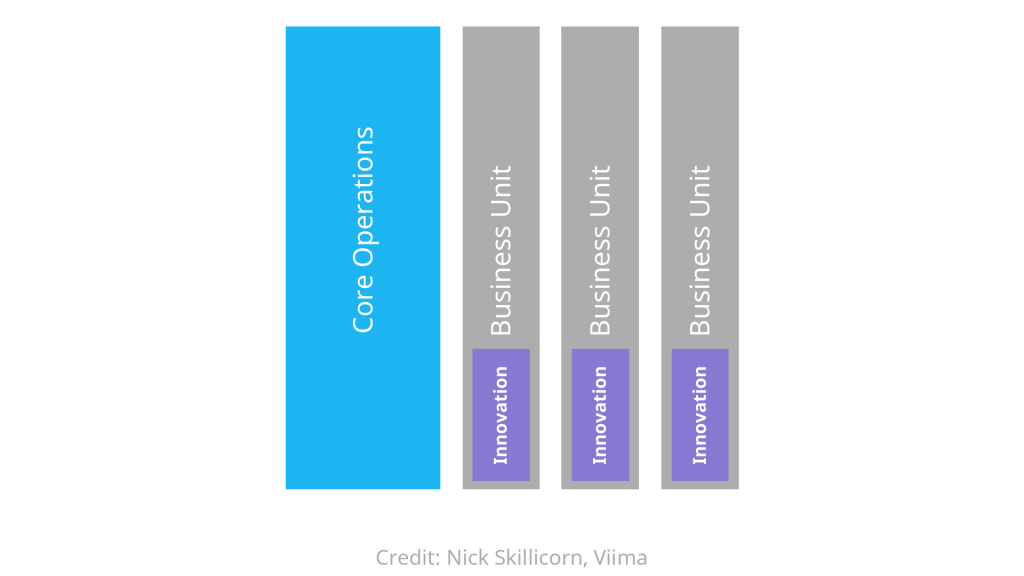
Embedded
Many organizations have relatively independent business units or product and brand teams, and for them it can often make sense for innovation to be embedded within these units.
Traditional examples of such an approach are companies like P&G and other CPG companies with strong brands. These companies are working hard to keep up to date with evolving trends and consumer needs to innovate and create new products for the consumer. However, the same can also be true for many other kinds of businesses, such as software companies with multiple products.
Depending on the industry and organization, these units might have varying levels of control over their innovations once they are on the market. For example, in CPG companies manufacturing, logistics and many other functions would likely be managed by core business operations instead of this unit.
Pros
- Better able to focus innovation on things that matter for each business, be they strategic projects or emerging customer needs
- More control over innovation resources and ability to get talent that meets specific needs
- Parallelization over different units can increase innovation throughput of the organization overall
- Easier to align innovation with business needs and plans within the unit
- The business case for investing in innovation is typically easy to make as you can start from low-hanging fruits that provide immediate value
Cons
- Innovation likely to be biased towards more applied and incremental projects due to focus on immediate business needs
- Some efforts may be duplicated between teams, especially if more long-term R&D work is being done
- Can lead to a silo-effect, extra need to focus on facilitating knowledge transfer between units
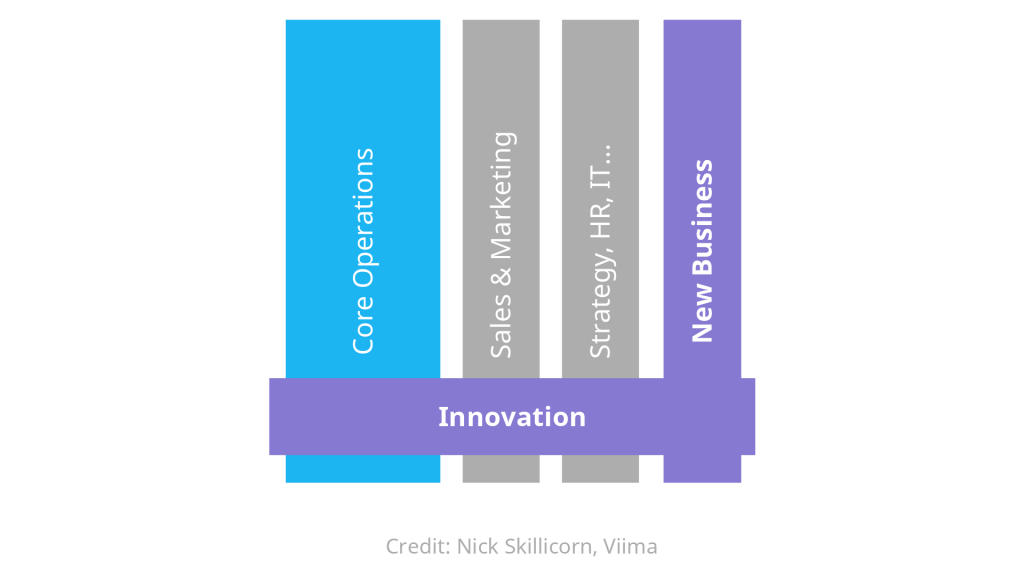
Ambidextrous
Our fifth approach is usually referred to as the ambidextrous organization. We’ve also seen it be referred to as the Hybrid model, and it’s quite a natural evolution from the previous archetypes as it seeks to combine the best of both worlds.
In a nutshell, the idea is that innovation should happen across the organization with existing business units focused on exploiting their current position through incremental innovation, and a separate dedicated unit being responsible for exploring and building the future of the organization through more radical or disruptive innovation.
In the ambidextrous model, existing units use incremental innovation to exploit the current position and new units are set up to explore and build future.
In practice, a new P&L responsible division will be setup for new non-core businesses, and the more incremental innovation will then be organised either as Embedded or Centralized.
If an organization does successfully implement such an approach, it can lead to exceptional long-term performance, but that’s of course easier said than done. For most organizations, this is likely to require a significant transformation, and it can be challenging to get everyone onboard, build the right processes, as well as to align goals and incentives the right way across the organization.
Pros
- Easier to build a balanced innovation portfolio with both strong short and long-term performance
- Enables building an innovation-oriented culture across the organization
- Enough resources for key projects across the organization
- Makes it easier to communicate the innovation strategy with clear roles and responsibilities for each part of the organization
- Can customize governance models to meet the needs of different types of innovation in different parts of the organization
Cons
- Expensive and difficult to build, as well as to maintain
- Requires clear leadership and a commitment to a transformation from the top
- Can demotivate innovation-oriented employees that are in the core business
- Usually requires extensive changes to processes and the re-skilling of managers and employees across the organization
- While easier than with most other models on paper, prioritization and division of responsibilities can still be challenging in practice

Decentralized
Our final model is the decentralized approach. If you look at any of the best innovators in the world, be it Apple, Tesla, SpaceX, or Amazon, this is closest to the model they use. None of these organizations has a centralized or dedicated team responsible for all innovation in the organization.
Instead, the organization decentralizes the responsibility for innovation to happen in individual teams (which are typically cross-functional and relatively small) across the organization. Each team is focused on figuring out how they could help the organization better reach their strategic goals, and innovation is just one of the key tools in that process.
If a team (or an individual leader or employee) comes across a big idea that shows promise but would require significant additional investments, they’ll apply for additional resources from management via a quick and streamlined process. If approved, that typically leads to another team being set up to pursue that idea.
This approach is sometimes called the permissionless model due to the significant freedom each team possesses to make decisions affecting their own work. The obvious advantages are that they usually know the problems intimately and have the resources, incentive, and know-how to solve them, and have fewer dependencies to other parts of the organization. That leads to an extremely high pace of innovation and innovation throughput for the organization, which together create a tremendous competitive advantage.

Having said that, this too isn’t exactly an easy model to implement for most organizations. Typically, this would require a fundamentally different mindset, leadership philosophy, and a significantly higher talent density. For the average organization, that means a full-blown transformation where most fundamentals in the organization would need to change, which of course isn’t feasible for many.
Pros
- Extremely high throughput and pace of innovation
- Ability to adapt, re-organize and meet changing demands quickly
- Strong focus on execution and value creation
- Clear roles and responsibilities
Cons
- Would require a fundamental transformation for most organizations
- Requires strong communication and strategic clarity from management
- Active management involvement required to remove barriers and to organize teams so that the portfolio remains balanced
- Requires high talent density across the organization, which can be very challenging to achieve in practice
- Continuously evolving and rapidly changing landscape might be too intensive for some employees
- Some work often initially duplicated across teams, but can be managed by creating horizontal support teams
Choosing the right approach for your organization
As you can see, every approach has their benefits, but also their disadvantages.
In our experience, the Hybrid and especially Decentralized are the likeliest approaches to lead to sustained levels of high innovation performance in the 21stcentury but implementing either isn’t exactly a walk in the park for a large organization. If you have the luxury of meeting (or are close to meeting) the prerequisites, these are the models I’d personally go for.
However, for many, that just isn’t the reality. Even if you’re like most organizations and don’t quite have the talent, leadership, or other prerequisites needed for these approaches, I’d keep either the Hybrid or Decentralized approach as your eventual goal to build towards.
Move control and decision-making down in the organization to be able to move faster, make more informed decisions, respond to changes quicker, and to simply innovate more.
However, instead of a major overnight transformation, you should be prepared for a set of smaller, gradual steps that build your capabilities and culture towards that future while solving the current problems with your processes and structures.
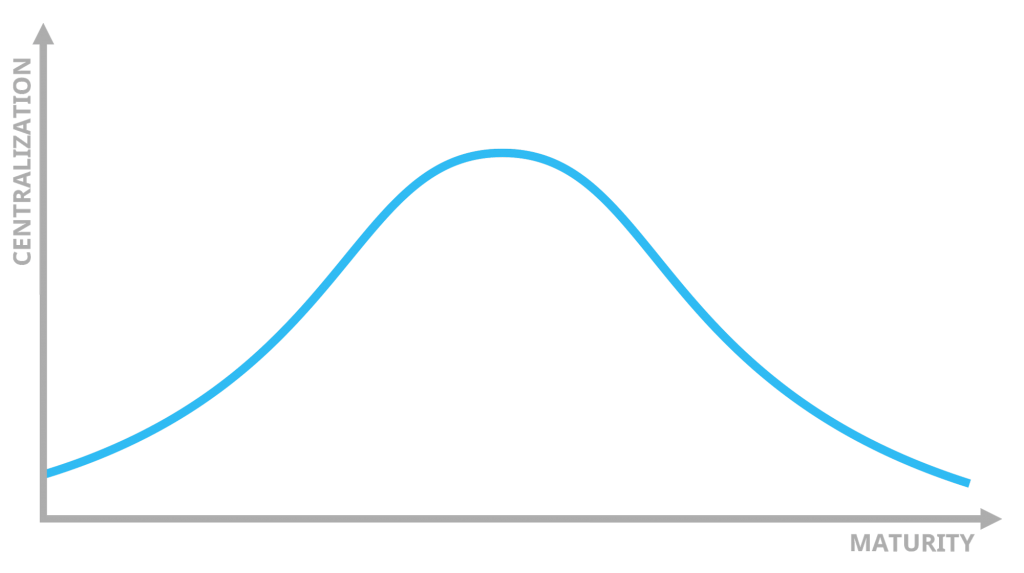
While not ideal in theory, in practice the journey towards becoming a mature top innovator typically first leads towards centralization for most incumbent organizations. They need to build their innovation strategy, knowledge and capabilities before they can successfully decentralize and move control and decision-making down in the organization to be able to move faster, make more informed decisions, respond to changes quicker, and to simply innovate more.
With that background, if such an approach is used, it’s crucial that this centralized innovation function understands and embraces their temporary role so that they are willing to relinquish control and power over innovation to others. All too often we see these leaders clinging on to the team, budget and power they’ve built long after it would’ve been in the organizations’ best interest to re-organize.
Best practices for organizing innovation
As we’ve discussed, if you’re planning to make changes to the way you organize innovation, most decisions will depend on your context. Still, there are a few things that are good to keep in mind regardless of the approach you end up choosing. Here’s my top three:
The best innovators continuously evolve
The first, and perhaps the most important point to remember is that the best innovators continuously evolve and improve the way they work. They don’t just pick one organizational structure and go with that forever. Instead, they are constantly looking for ways to re-organize their efforts so that they work on whatever is likely to best help them reach their goals. This is of course one of the fundamental strengths of the Decentralized model but applies to other approaches too.
This is also in line with how the most successful organizations approach re-organizations in general. They don’t just wait until the old structure is burning, they act proactively to position themselves for the future they want to create.
Clear roles and decision-making structures
It’s pretty obvious, but if people don’t know who can make a decision on an idea that they may have, or even who’s responsibility it would fall under, odds are that not a lot of innovation will happen.
The reality is that there will always be some ambiguity and overlap, especially in fast moving environments, but clear roles and decision-making structures are regardless important for an organization that wants to innovate.
If projects or decisions seem to get stuck, or turf battles seem to consistently pop up in your organization, unclear roles and ambiguous decision-making are likely to be the main culprits.
Organize according to strategy and plan for the execution
Again, it might sound obvious, but especially with innovation, the differences can be dramatic. Organization is the link between your strategy and your execution, so make sure it isn’t detached from the realities of what it will take to reach your goals with innovation.
To use a bit of a simplified example, if your strategy is focused on creating new business from emerging disruptive technologies, then the Embedded model probably won’t cut it as your innovators will be kept busy by the priorities from the core business.

Plan for the execution, on the other hand means that each team should have the resources and the freedom needed to reach your goals. If, using our previous example, you allocate just a few engineers to the team and then hope that sales will magically turn those technologies into booming businesses, odds are very much against you.
In other words, try to allocate resources so that the team has everything they need to reach their goals. While this sounds super basic, we still see these mistakes frequently when innovation is a bit of an afterthought for management.
Conclusion
As is probably evident by now, no structure or approach to governing innovation is ever going to be perfect, at least for long. As your goals change or your business and industry keep evolving, you will need to change and evolve too.
Even though organizing innovation doesn’t seem to get the same kind of attention as innovation strategy or culture, it’s extremely important, nevertheless. Get it wrong, and it will be almost impossible for your organization to succeed at innovation. Get it right, and you’ll at the very least have a realistic shot at that.
Hopefully this article has provided you with more thoughts on the topic, and some views on what to do and not-to-do.
This article was originally published in Viima’s blog.
Image credits: Unsplash, Viima, Nick Skillicorn
![]() Sign up here to get Human-Centered Change & Innovation Weekly delivered to your inbox every week.
Sign up here to get Human-Centered Change & Innovation Weekly delivered to your inbox every week.
Pingback: What Latest Research Reveals About Innovation Management Software | Human-Centered Change and Innovation
Pingback: Top 100 Innovation and Transformation Articles of 2022 | Human-Centered Change and Innovation